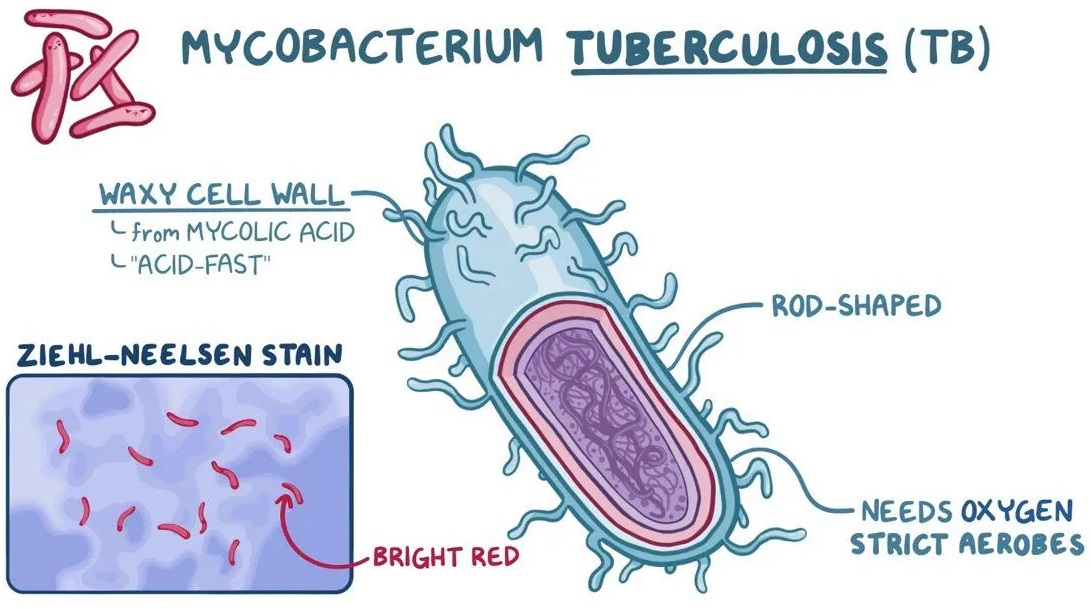Mycobacterium tuberculosis - Classification, Characteristics, Pathogenesis, Virulence Factors
Classification of Mycobacterium tuberculosis
Mycobacterium tuberculosis is classified phenotypically as follows.
Domain: Bacteria
Phylum: Actinomycetota
Class: Actinomycetia
Order: Mycobacteriales
Family: Mycobacteriaceae
Genus: Mycobacterium
Species: tuberculosis
History of Mycobacterium tuberculosis
Mycobacterium tuberculosis was first identified by Robert Koch in 1882.
General characteristics of Mycobacterium tuberculosis
Mycobacterium tuberculosis is a complex facultative intracellular pathogen, non-pigmented, pleomorphic rods arranged singly or in groups, measuring 2-3 μm x 0.3-0.4 μm (l x w). It is a non-sporing, non-motile, non-capsulated, obligate aerobe, gram-positive but weakly stained by gram stain.
Their hydrophobic cell wall can resist acid/alkali/osmotic lysis and is impermeable to antimicrobials. On acid-fast staining with 20% acid alcohol, red bacilli can be seen.
In fluorescence staining, it shows golden yellow color fluorescent bacilli against the dark background.
Other general characteristics of Mycobacterium tuberculosis are that they are slow growers (generation time: 12-24 hours) with an optimum temperature of 37°C and pH of about 6.4 – 7.0. They grow in media containing eggs, asparagine, potatoes, serum, and meat extract. Lowenstein Jensen (LJ) media contains egg yolk; it gives rough (irregular and wrinkled), tough, and buff (pale yellow) colonies.
Mycobacterium tuberculosis can also be grown in Ogawa’s medium, Dorset egg medium, middle brook 7H10, 7H11, Loeffler medium, etc. Also, a liquid medium like Dubas and middle brook 7H9 is used for AST and Ag preparation for vaccines.

Fig: Mycobacterium tuberculosis (Source: Osmosis)
Pathogenesis, virulence factors of Mycobacterium tuberculosis
Mycobacterium tuberculosis causes tuberculosis. The capability of Mycobacterium tuberculosis for intracellular growth in alveolar macrophages is the main determinant of the virulence of the bacteria.
The mode of infection of Mycobacterium tuberculosis is by direct inhalation of aerosolized bacilli (1-400 in no.) contained in droplets of expectorated sputum, coughing, and sneezing (even a single viable bacillus can lead to infection)
The majority of inhaled Mycobacterium tuberculosis bacilli are arrested by the natural host defense present in URT
Bacilli that reach the lungs are ingested by alveolar macrophages.
However, they can multiply inside macrophages either by:
resistance to lysosomal content
escape from the phagosome into the macrophage’s cytoplasm
inhibition of phagolysosome formation
Those macrophages that kill Mycobacterium tuberculosis bacteria, present Ag with MHCII proteins which activate CD4 cells
CD4 cells further, with the help of cytokines, attract macrophages at the site. The macrophages produce lytic enzymes that kill bacilli as well as nearby tissues
Macrophages fuse to form a giant cell called granuloma (aka hard tubercle) which is more potent. It damages nearby tissue, thus extending cellular damage. If granuloma is not formed, caseous material (solid or semisolid) is left at the primary lesion
In the majority of cases, the lesions heal by themselves leaving a calcified nodule. The bacteria remain in the latent phase, which can reactivate later
The inability to eliminate Mycobacterium tuberculosis infection can lead to systemic hypersensitivity to Mycobacterium antigens